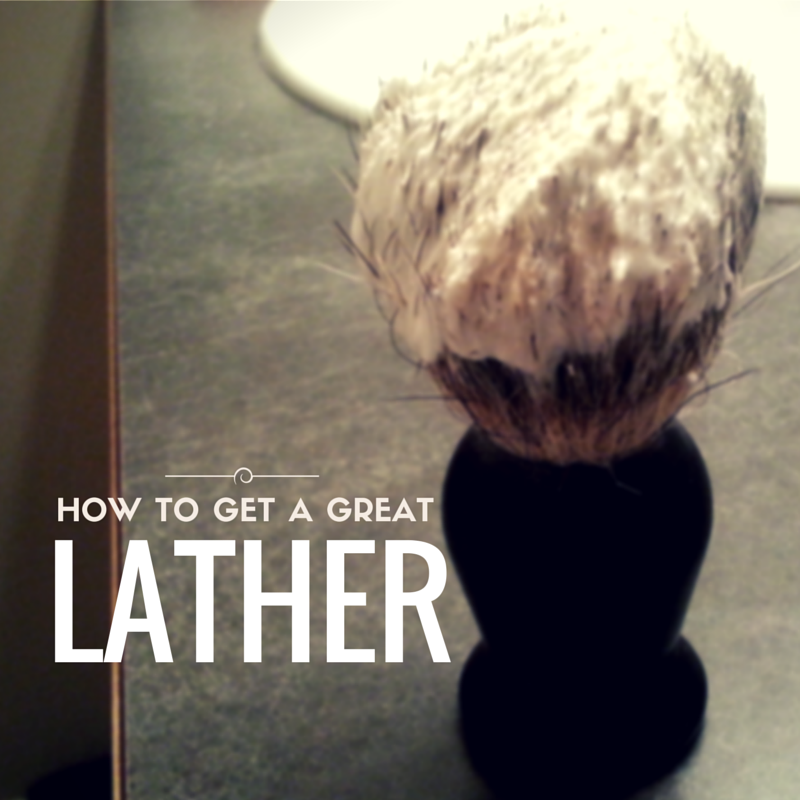Lather is the most important thing about a shaving soap. It’s got to be rich, long-lasting, slick, and moisturizing – and it can’t dry or irritate skin.
If you’ve been looking into how to make shaving soap, you’ve probably heard some off-putting numbers about how many recipe variations people have gone through to get a good lather. It’s my goal to help you skip some of that expensive and time-consuming process. In this post, we’ll get into the characteristics of an awesome lather and some of the fats soap makers use to achieve it.
As we discussed in Anatomy of a Shaving Soap, a really great shaving soap has a few distinctive qualities:
- Hydration of the skin and hair.
- Lifts the hair.
- Thick, stable lather. You should only have to work the lather up once, and you don’t want it to dry out on your face.
- Cushions the face, allowing the razor to glide over the skin.
We won’t talk about fragrance or color for now, but look out for these in future posts!
Hydration
You can ensure your shaving soap is moisturizing with Superfatting. Superfatting ensures that there is some leftover oil in the soap.
Of course, this means that the properties of that leftover oil become very important.
This is why many shaving soap manufacturers will superfat with luxurious fats such as avocado oil or shea butter. The moisturizing properties of the leftover oil are transferred to the finished soap.
If you were to use, say, coconut oil to superfat, you’d get a soap that makes your skin feel similar to when you just rub coconut oil on it.
On the other hand, you can keep the coconut (etc) oil for use during saponification, and use a small amount of moisturizing oil that has more benefits for your skin.
This way, you keep your costs down by using cheaper oils in your soap base, and using fancy and expensive oils as a superfat, where they really count. This will help you make shaving soap with all the lather properties you want, while leaving your face feeling great!
Lifts the Hair
Shaving soap with a thick lather helps lift the hair. Primarily, this is aided by the use of a great brush.
Check out Sharpologist’s fantastic shaving brush buyer’s guide if you’re looking for an introduction to shaving brushes, bristle types and bristle grades, or if you’re not sure what to look for.
Popular choices include the Escali 100% Pure Badger for a bargain brush, the Parker Synthetic if you’re looking for a vegan/synthetic brush, the Ambroley Best Badger for a mid-range brush at a good price, or the Parker 100% Silvertip Badger Bristle Shaving Brush if you’re looking to skip the cheaper brushes for a great long-term brush.
The bristles of the brush will help work the lather up underneath the hair. Better brushes tend to hold more water, shed less, and don’t feel bristly on your face.
A good brush is important. It works in tandem with your homemade shaving soap to work a nice thick lather up under your beard.
But, if your lather is thin and collapses, the hair won’t be lifted away from the face for long. That’s why it’s so important to have…
Thick & Stable Lather
Thick, rich, creamy lather is a wonderful thing. Not only is it pleasing to look at, it cushions your face and keeps your facial hair lifted.
But thick lather is nothing if it lacks staying power. If you’ve ever had a shaving soap or cream dry up on your face, you know that it can be a little inconvenient – and if you plow through it anyway, you’ll find it won’t produce a very satisfactory shave.
It’s not enough for a soap to produce a rich lather – it’s got to stay that way.
That’s why fats like tallow, palm oil, and stearic acid are so popular in commercial shaving soap – and why they’re a great place to start when you make your own homemade shaving soap. They produce a thick lather that stays inflated and hydrated for a long time.
Cushion & Slip
Cushion is a somewhat nebulous term used among the shaving community that generally means a slick lather which protects your face. We’ll refer to it as slip, since I think that’s a more accurate term of the quality we’re looking for.
Have you ever finished a shave, realized you missed a small patch of stubble, and decided to do a quick touch-up?
You probably noticed that your face causes a heck of a lot of friction very soon after you’ve swiped the soap away from it. This is the opposite of slip.
Slip causes the razor to glide over your face, slicing away hairs with minimal friction and irritation. Slip produces a really comfortable shave, and it is glorious.
Slip is often enhanced by the addition of extra glycerin or clay. However, you should be aware that some shavers worry that clay may dull blades faster.
——————————
Shavers & soapers – thanks for reading! If you liked this article, please help me out and share it.
What is most important to you in a lather? What other questions do you have about how to make shaving soap? Let me know in the comments below!
Keep your eyes peeled for an awesome announcement next week!

